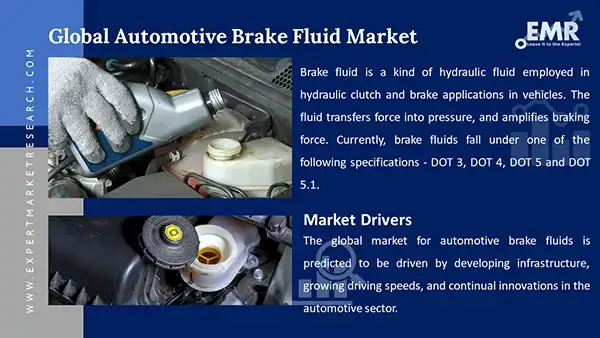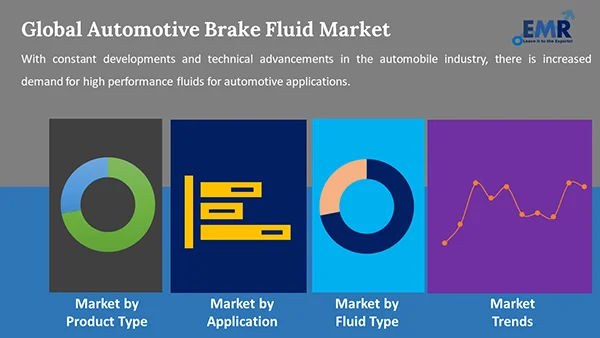
Consumer Insights
Uncover trends and behaviors shaping consumer choices today
Procurement Insights
Optimize your sourcing strategy with key market data
Industry Stats
Stay ahead with the latest trends and market analysis.
The global automotive brake fluid market is expected to grow at a CAGR of 2.40% during the period 2026-2035.
Base Year
Historical Period
Forecast Period
Compound Annual Growth Rate
2.4%
2026-2035
*this image is indicative*
Developing infrastructure, rising driving speeds, and constant advancements in the automotive industry are expected to drive the global market for automotive brake fluids. North America, Europe and Asia are likely to be key markets.
Brake fluid is a kind of hydraulic fluid employed in hydraulic clutch and brake applications in vehicles. The fluid transfers force into pressure, and amplifies braking force. Currently, brake fluids fall under one of the following specifications - DOT 3, DOT 4, DOT 5 and DOT 5.1. Under DOT specifications, two reference tests are laid down for brake fluids – dry boiling point (boiling point of fresh fluids) and wet boiling points (boiling point after the fluid has absorbed moisture, this signifies brake fluid after time expended in real conditions). Brake fluids are chiefly employed in braking and clutch systems of on-road and off-road vehicles. Applications include automobiles, motorcycles and light trucks.

Read more about this report - REQUEST FREE SAMPLE COPY IN PDF
DOT 3, 4 and 5.1 fluids are hygroscopic and glycol based; these fluids absorb atmospheric moisture. Glycol based brake fluids begin to absorb moisture soon after these are placed in the hydraulic brake system or shown to air. Moisture seeps in the fluid via microscopic pores in rubber hoses, past seals, and air exposure. The water entering the system is spread throughout the brake fluid instead of getting pooled in low spots (due to the difference in the weights of water and the brake fluid). Thus, the boiling point of the whole brake fluid is kept high as against the situation where accumulated pools of water in the system would boil sooner than the brake fluid. DOT 3, 4 and 5.1 also differ in terms of boiling point. The higher the boiling point of a brake fluid, the more heat the fluid can tolerate. Among the three glycol-based brake fluids, DOT 5.1 has the highest boiling point and DOT 3 the lowest. The majority of brake fluids presently in use are glycol based and appropriate for high performance vehicles in which braking systems touch moderate brake temperatures. DOT 5 brake fluid is hydrophobic and silicone based, thus, it repels water. As the silicone fluid does not absorb atmospheric moisture while in use, it offers better service life and enhances corrosion resistance of the key elements of the braking system. While silicone-based DOT 5 was designed to offer higher temperature performance as compared to glycol DOT 4, it does not provide lubrication to ABS pumps comparable to glycol-based fluids.
With constant developments and technical advancements in the automobile industry, there is increased demand for high performance fluids for automotive applications. Leading companies are looking to offer modern solutions to meet industry demands and standards. For example, HYDRAULAN® brake fluids by BASF are designed to meet current and future needs of the industry while maintaining stringent safety requirements demanded by customers. The solution offers high thermal stability, superior corrosion protection for metals, better elastomer compatibility, very low viscosity at low temperatures, and superior lubrication.
In 2021, Valvoline announced the launch of XEV, the brand's first China-based release of hybrid, plug-in hybrid and pure electric vehicle products. XEV refers to a set of hybrid and EV fluids, including brake fluids among motor oil, battery protection fluid and transmission fluid. In 2019, Valvoline announced a product line to serve electric vehicles, including Valvoline EV Brake Fluid; the formulations featured high wet and dry boiling points, noise elimination, brake fade reduction and low viscosity at low temperatures for modern Anti-lock Brake Systems (ABS), Electronic Stability Programs (ESP) and Advance Driver Assistance Systems (ADAS).
In 2019, Brakes India launched DOT 4+ brake and clutch fluid for ABS-equipped vehicles, with features such as higher boiling point (above 255degree C), low viscosity (at -40degree C) and fulfilment of SAE J1704, FMVSS 116 and IS 8654 specifications. According to the company, the solution was developed through extensive in-house expertise and the fluids were tested to strict standards.

Read more about this report - REQUEST FREE SAMPLE COPY IN PDF
The EMR’s report titled “Automotive Brake Fluid Market Report and Forecast 2026-2035" offers a detailed analysis of the market based on the following segments:
By fluid type, the market is segmented into:
By product type, the market is classified into:
By application, the market is divided into:
By region, the market is segmented into:
The report presents a detailed analysis of the following key players in the market, looking into their capacity, and latest developments like capacity expansions, plant turnarounds, and mergers and acquisitions:
The EMR report gives an in-depth insight into the industry by providing a SWOT analysis as well as an analysis of Porter’s Five Forces model.




*While we strive to always give you current and accurate information, the numbers depicted on the website are indicative and may differ from the actual numbers in the main report. At Expert Market Research, we aim to bring you the latest insights and trends in the market. Using our analyses and forecasts, stakeholders can understand the market dynamics, navigate challenges, and capitalize on opportunities to make data-driven strategic decisions.*
Get in touch with us for a customized solution tailored to your unique requirements and save upto 35%!
The market is estimated to grow at a CAGR of 2.40% between 2026 and 2035.
The major drivers of the market include the rising cases of road accidents, stringent government regulations aimed towards bolstering safety on roads, rising traffic congestion, and rising demand for automobiles with smooth braking system.
The technological innovations and rising investments by the key automotive market players to enhance the braking quality of an automobiles are the key trends guiding the growth of the industry.
The major regions in the industry are North America, Latin America, the Middle East and Africa, Europe, and the Asia Pacific.
Petroleum and non-petroleum are the major fluid types included in the market report.
DOT 3, DOT 4, DOT 5, and DOT 5.1 are the significant product types based on which the market has been segmented.
Light commercial vehicles and passenger cars, among others are the different applications of the product.
The major players in the industry are BASF SE, Chevron Corporation, The Dow Chemical Company, Exxon Mobil Corporation, and Valvoline Inc, among others.
Explore our key highlights of the report and gain a concise overview of key findings, trends, and actionable insights that will empower your strategic decisions.
| REPORT FEATURES | DETAILS |
| Base Year | 2025 |
| Historical Period | 2019-2025 |
| Forecast Period | 2026-2035 |
| Scope of the Report |
Historical and Forecast Trends, Industry Drivers and Constraints, Historical and Forecast Market Analysis by Segment:
|
| Breakup by Fluid Type |
|
| Breakup by Product Type |
|
| Breakup by Application |
|
| Breakup by Region |
|
| Market Dynamics |
|
| Competitive Landscape |
|
| Companies Covered |
|
| Report Price and Purchase Option | Explore our purchase options that are best suited to your resources and industry needs. |
| Delivery Format | Delivered as an attached PDF and Excel through email, with an option of receiving an editable PPT, according to the purchase option. |
Datasheet
One User
USD 2,499
USD 2,249
tax inclusive*
Single User License
One User
USD 3,999
USD 3,599
tax inclusive*
Five User License
Five User
USD 4,999
USD 4,249
tax inclusive*
Corporate License
Unlimited Users
USD 5,999
USD 5,099
tax inclusive*
*Please note that the prices mentioned below are starting prices for each bundle type. Kindly contact our team for further details.*
Flash Bundle
Small Business Bundle
Growth Bundle
Enterprise Bundle
*Please note that the prices mentioned below are starting prices for each bundle type. Kindly contact our team for further details.*
Flash Bundle
Number of Reports: 3
20%
tax inclusive*
Small Business Bundle
Number of Reports: 5
25%
tax inclusive*
Growth Bundle
Number of Reports: 8
30%
tax inclusive*
Enterprise Bundle
Number of Reports: 10
35%
tax inclusive*
How To Order

Select License Type
Choose the right license for your needs and access rights.

Click on ‘Buy Now’
Add the report to your cart with one click and proceed to register.

Select Mode of Payment
Choose a payment option for a secure checkout. You will be redirected accordingly.
Gain insights to stay ahead and seize opportunities.

Get insights & trends for a competitive edge.

Track prices with detailed trend reports.

Analyse trade data for supply chain insights.

Leverage cost reports for smart savings

Enhance supply chain with partnerships.

Connect For More Information
Our expert team of analysts will offer full support and resolve any queries regarding the report, before and after the purchase.
Our expert team of analysts will offer full support and resolve any queries regarding the report, before and after the purchase.
We employ meticulous research methods, blending advanced analytics and expert insights to deliver accurate, actionable industry intelligence, staying ahead of competitors.
Our skilled analysts offer unparalleled competitive advantage with detailed insights on current and emerging markets, ensuring your strategic edge.
We offer an in-depth yet simplified presentation of industry insights and analysis to meet your specific requirements effectively.
Share